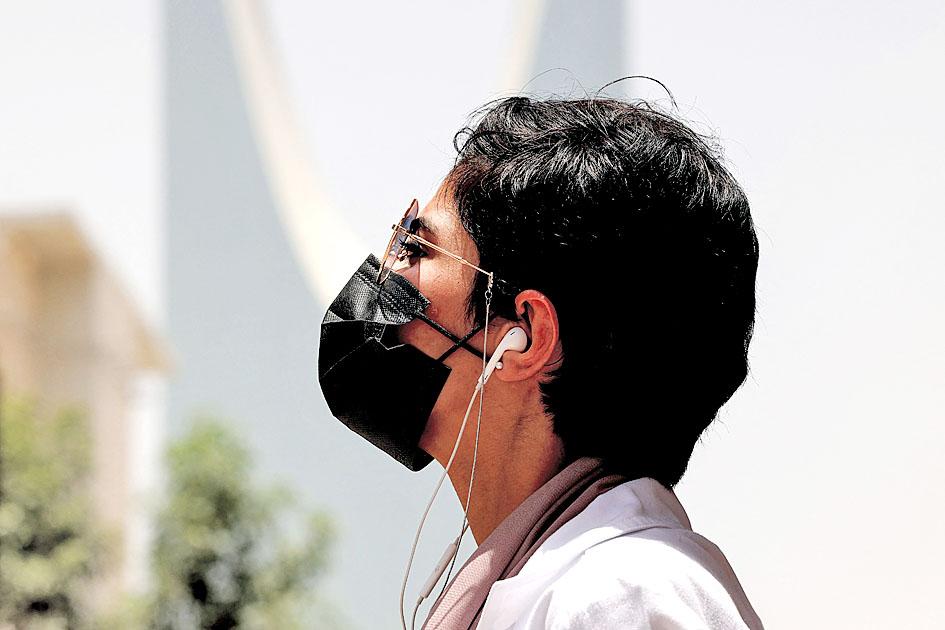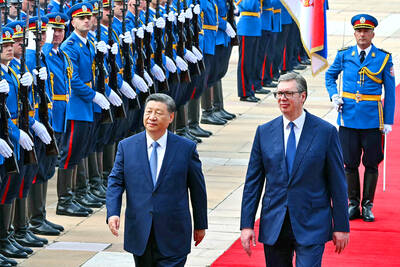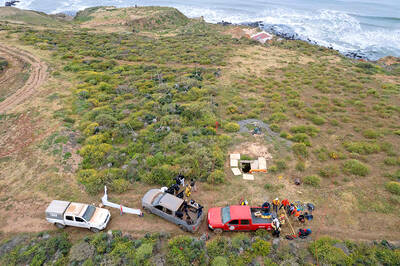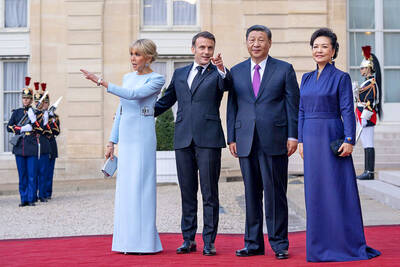When Saudi Arabian doctor Safi took a new job at a hospital in the capital, Riyadh, she decided to offset her standard white lab coat with a look she once would have considered dramatic.
Walking into a Riyadh salon, she ordered the hairdresser to chop her long, wavy locks all the way up to her neck, a style increasingly in vogue among working women in the conservative kingdom.
The haircut — known locally by the English word “boy” — has become strikingly visible on the streets of the capital, and not just because women are no longer required to wear hijab headscarves under social reforms pushed by Crown Prince Mohammed bin Salman, Saudi Arabia’s de facto ruler.

Photo: AFP
As more women join the workforce, many describe the “boy” cut as a practical, professional alternative to the longer styles they might have preferred before finding a job.
For Safi, who asked to be identified by a pseudonym to preserve her anonymity, the look is also a form of protection from unwanted male attention, allowing her to focus on her patients.
“People like to see femininity in a woman’s appearance,” she said. “This style is like a shield that protects me from people and gives me strength.”
At one salon in central Riyadh, demand for the “boy” cut has spiked, with seven or eight customers out of 30 requesting it on any given day, hairdresser Lamis said.
“This look has become very popular now,” she said. “The demand for it has increased, especially after women entered the labor market.
“The fact that many women do not wear the hijab has highlighted its spread” while spurring even more customers to try it out, especially women in their late teens and 20s, she said.
The lifting of the headscarf requirement is just one of many changes that have reordered daily life for Saudi Arabian women under Prince Mohammed, who was named heir to his 86-year-old father, King Salman, five years ago.
Saudi Arabian women are no longer banned from concerts and sports events, and in 2018 they gained the right to drive.
The kingdom has also eased so-called guardianship rules, meaning women can now obtain passports and travel abroad without a male relative’s permission.
However, reforms have been accompanied by a crackdown on women’s rights activists, part of a broader campaign against dissent.
Getting more women to work is a major component of Prince Mohammed’s Vision 2030 plan to make Saudi Arabia less dependent on oil.
The plan initially called for women to account for 30 percent of the workforce by the end of the decade, but already that figure has reached 36 percent, Saudi Arabian Assistant Minister of Tourism Princess Haifa Al Saud told the World Economic Forum in Davos last month.
“We see women today in every single job type,” Haifa said, adding that 42 percent of small and medium-sized enterprises are women-owned.
Many working women said the “boy” cut is a tool for navigating their new professional lives.
“I am a practical woman and I don’t have time to take care of my hair,” said Abeer Mohammed, a 41-year-old mother of two who runs a men’s clothing store.
“My hair is curly, and if my hair grows long, I will have to spend time that is not available to me taking care of it in the morning,” she said.
Saudi Arabia has traditionally outlawed men who “imitate women” or wear women’s clothing, and vice versa.
Rose, a 29-year-old shoe saleswoman at a Riyadh mall, sees her close-cropped hair as a way to assert her independence from men.
It “gives me strength and self-confidence... I feel different, and able to do what I want without anyone’s guardianship,” said Rose, who did not want to give her full name.
“At first, my family rejected the look, but over time they got used to it,” she added.
Such acceptance partly reflects the influence of Arab stars like actress Yasmin Raeis or singer Shirene who have adopted the style, Egyptian stylist Mai Galal said.
“A woman who cuts her hair in this way is a woman whose character is strong because it is not easy for women to dispense with their hair,” Galal said.
“We want to say that we exist, and our role in society does not differ much from that of men,” said Nouf, who works in a cosmetics store and did not want to give her full name, about the style’s message. “It’s show of women’s strength.”

MONEY MATTERS: Xi was to highlight projects such as a new high-speed railway between Belgrade and Budapest, as Serbia is entirely open to Chinese trade and investment Serbian President Aleksandar Vucic yesterday said that “Taiwan is China” as he made a speech welcoming Chinese President Xi Jinping (習近平) to Belgrade, state broadcaster Radio Television of Serbia (RTS) said. “We have a clear and simple position regarding Chinese territorial integrity,” he told a crowd outside the government offices while Xi applauded him. “Yes, Taiwan is China.” Xi landed in Belgrade on Tuesday night on the second leg of his European tour, and was greeted by Vucic and most government ministers. Xi had just completed a two-day trip to France, where he held talks with French President Emmanuel Macron as the

With the midday sun blazing, an experimental orange and white F-16 fighter jet launched with a familiar roar that is a hallmark of US airpower, but the aerial combat that followed was unlike any other: This F-16 was controlled by artificial intelligence (AI), not a human pilot, and riding in the front seat was US Secretary of the Air Force Frank Kendall. AI marks one of the biggest advances in military aviation since the introduction of stealth in the early 1990s, and the US Air Force has aggressively leaned in. Even though the technology is not fully developed, the service is planning

INTERNATIONAL PROBE: Australian and US authorities were helping coordinate the investigation of the case, which follows the 2015 murder of Australian surfers in Mexico Three bodies were found in Mexico’s Baja California state, the FBI said on Friday, days after two Australians and an American went missing during a surfing trip in an area hit by cartel violence. Authorities used a pulley system to hoist what appeared to be lifeless bodies covered in mud from a shaft on a cliff high above the Pacific. “We confirm there were three individuals found deceased in Santo Tomas, Baja California,” a statement from the FBI’s office in San Diego, California, said without providing the identities of the victims. Australian brothers Jake and Callum Robinson and their American friend Jack Carter

CUSTOMS DUTIES: France’s cognac industry was closely watching the talks, fearing that an anti-dumping investigation opened by China is retaliation for trade tensions French President Emmanuel Macron yesterday hosted Chinese President Xi Jinping (習近平) at one of his beloved childhood haunts in the Pyrenees, seeking to press a message to Beijing not to support Russia’s war against Ukraine and to accept fairer trade. The first day of Xi’s state visit to France, his first to Europe since 2019, saw respectful, but sometimes robust exchanges between the two men during a succession of talks on Monday. Macron, joined initially by EU Commission President Ursula von der Leyen, urged Xi not to allow the export of any technology that could be used by Russia in its invasion